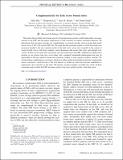| dc.contributor.author | Elor, Gilly | |
| dc.contributor.author | Liu, Hongwan | |
| dc.contributor.author | Slatyer, Tracy Robyn | |
| dc.contributor.author | Soreq, Yotam | |
| dc.date.accessioned | 2018-08-22T19:42:07Z | |
| dc.date.available | 2018-08-22T19:42:07Z | |
| dc.date.issued | 2018-08 | |
| dc.date.submitted | 2018-02 | |
| dc.identifier.issn | 2470-0010 | |
| dc.identifier.issn | 2470-0029 | |
| dc.identifier.uri | http://hdl.handle.net/1721.1/117493 | |
| dc.description.abstract | We explore the possibility that bound states involving dark matter particles could be detected by resonance searches at the LHC and the generic implications of such scenarios for indirect and direct detection. We demonstrate that resonance searches are complementary to monojet searches and can probe dark matter masses above 1 TeV with current LHC data. We argue that this parameter regime, in which the bound-state resonance channel is the most sensitive probe of the dark sector, arises most naturally in the context of nontrivial dark sectors with large couplings, nearly degenerate dark matter–like states, and multiple force carriers. If dark sector bound states are present and can be detected at the LHC, annihilation of dark matter particles in our galactic halo may occur either with a minimal Sommerfeld enhancement that may be appreciable or through radiative bound-state formation, leading to large signals in indirect searches. We calculate these complementary constraints, which favor either models in which the bound state–forming dark matter constitutes a small fraction of the total density or models in which the late-time annihilation is suppressed at low velocities or late times. We present concrete examples of models that satisfy all these constraints and in which the LHC resonance search is the most sensitive probe of the dark sector. | en_US |
| dc.description.sponsorship | United States. Department of Energy. High Energy Physics Division (Grant DE-SC00012567) | en_US |
| dc.description.sponsorship | United States. Department of Energy (Grant DE-SC0013999) | en_US |
| dc.description.sponsorship | United States. Department of Energy (Grant DE-SC00015476) | en_US |
| dc.description.sponsorship | MIT Research Support Committee | en_US |
| dc.publisher | American Physical Society | en_US |
| dc.relation.isversionof | http://dx.doi.org/10.1103/PhysRevD.98.036015 | en_US |
| dc.rights | Creative Commons Attribution | en_US |
| dc.rights.uri | http://creativecommons.org/licenses/by/3.0 | en_US |
| dc.source | American Physical Society | en_US |
| dc.title | Complementarity for dark sector bound states | en_US |
| dc.type | Article | en_US |
| dc.identifier.citation | Elor, Gilly, et al. “Complementarity for Dark Sector Bound States.” Physical Review D, vol. 98, no. 3, Aug. 2018. | en_US |
| dc.contributor.department | Massachusetts Institute of Technology. Department of Physics | en_US |
| dc.contributor.mitauthor | Liu, Hongwan | |
| dc.contributor.mitauthor | Slatyer, Tracy Robyn | |
| dc.contributor.mitauthor | Soreq, Yotam | |
| dc.relation.journal | Physical Review D | en_US |
| dc.eprint.version | Final published version | en_US |
| dc.type.uri | http://purl.org/eprint/type/JournalArticle | en_US |
| eprint.status | http://purl.org/eprint/status/PeerReviewed | en_US |
| dc.date.updated | 2018-08-21T18:00:25Z | |
| dc.language.rfc3066 | en | |
| dspace.orderedauthors | Elor, Gilly; Liu, Hongwan; Slatyer, Tracy R.; Soreq, Yotam | en_US |
| dspace.embargo.terms | N | en_US |
| dc.identifier.orcid | https://orcid.org/0000-0003-2486-0681 | |
| dc.identifier.orcid | https://orcid.org/0000-0001-9699-9047 | |
| mit.license | PUBLISHER_CC | en_US |
